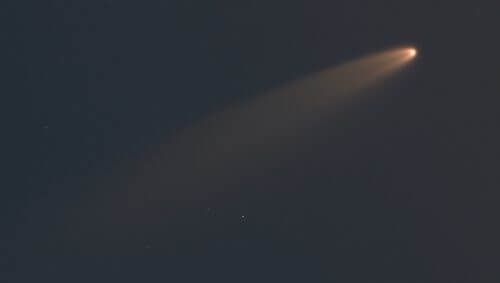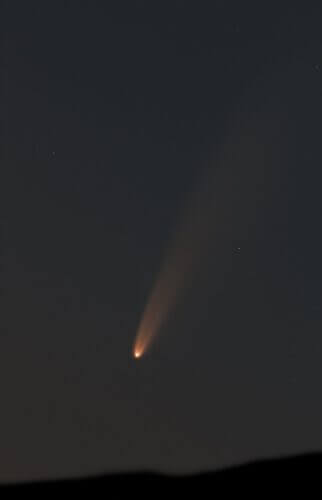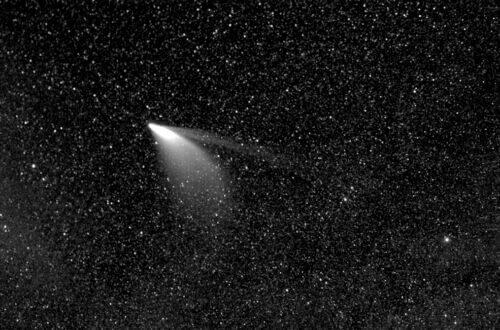Astronomer Michael Tzukran photographed the comet this week from the sky of Israel - the photos in the body of the article * At the beginning of July, the comet reached the point closest to the Sun approximately in the orbit of the planet Hema, but now it passes by the point closest to the Earth, so it is easier to observe it

C / 2020 F3, or Comet NEOWISE, is a comet with a nearly parabolic orbit discovered on March 27 at magnitude 10, which is 2 AU (300 million km) from the Sun and 1.7 AU (250 million km) from Earth .
By the end of July 2020 it will be bright enough to be visible to the naked eye to observers in the Northern Hemisphere. In the early morning, the comet was seen low on the northeastern horizon, below the star Capella. In the evening you can see the comet in the northwestern sky. In the second half of July 2020, Comet NEOWISE will be seen passing through the constellation Ursa Major.
The comet has the distinction of being one of the brightest visible to observers in the Northern Hemisphere since Comet Hale-Bop in 1997. In good, light-free conditions, it can be clearly seen with the unaided eye, and is expected to remain visible to the unaided eye throughout most of July 2020.
Comet watchers are enjoying the new comet from NEOWISE that has been discovered since it was first observed in March 2020. Now that it is visible to the naked eye, under dark sky conditions, all kinds of terrestrial observers are checking out the visitor.
The comet, whose core diameter is 5 km, came right close to the orbit of Hema on July 3. This very close pass by the Sun cooks the uppermost layers of the comet, causing gas and dust to erupt from the icy surface and creating a large tail of fragments. And yet the comet managed to survive this intense roasting.
Spectators all over the world are racing to see the natural fireworks display before the jet accelerates its way deep into space and away from us. Even the astronauts aboard the International Space Station spotted it from their vantage point high above Earth's atmosphere.

In the coming days it will be visible to the naked eye about an hour before sunrise, near the horizon in the northeastern sky. Viewers may see the central nucleus of the comet. Using binoculars will give viewers a good look at the nebulous comet and its long tail as it moves away from the Sun. As of this week (July 11), it can be viewed in the evening hours.
Shot from a far angle
Another NASA spacecraft, NASA's Parker Solar Probe, observed the comet from another angle, an angle that cannot be seen from Earth.
NEOWISE's real name is C/2020 F3, but since the NEOWISE telescope discovered it, the name stuck. WISE was a satellite whose mission was to survey the sky in the infrared range for distant objects, but in 2013 it was converted to detect asteroids and comets in the solar system, and its name was changed to - NEOWISE, NEO - Near Earth Object, meaning the search for near-Earth objects, as part of the general global effort to locate objects that may threaten the earth.
Parker has nothing to do with finding asteroids and comets. Its job is to study the Sun, but as it turns out it is in a great position to photograph the comet NEOWISE. The most important image is that of NEOWISE on July 5, shortly after the closest point in its orbit to the Sun. The comet was particularly active when exposed to solar radiation, and two tails can now be discerned.
Comets contain a lot of water ice and other volatile substances, and when they heat up during their sacrifices to the sun they form tails of gas and dust. These tails always point away from the Sun, regardless of the comet's actual orbit.
One of the tails is the dust tail, and it is the larger of the two. The other tail is the ion tail (IONS). Scientists want to use one of the tools found in Parker - WISPR to study it. WISPR's purpose of observation - to measure the speed of dust loss from the comet's nucleus.

He should return to us in about 7,000 years. I wonder who and if at all will watch it then.
Michael Zukran uploads space photos to a dedicated page on Instagram

2 תגובות
in her
It is possible to get guidance/explanation on how to watch a comet, I didn't understand from the article
A reference to a useful source is missing for those who would like to find the comet on the map of the sky. A link to the Israeli Astronomical Society for example or to another body.